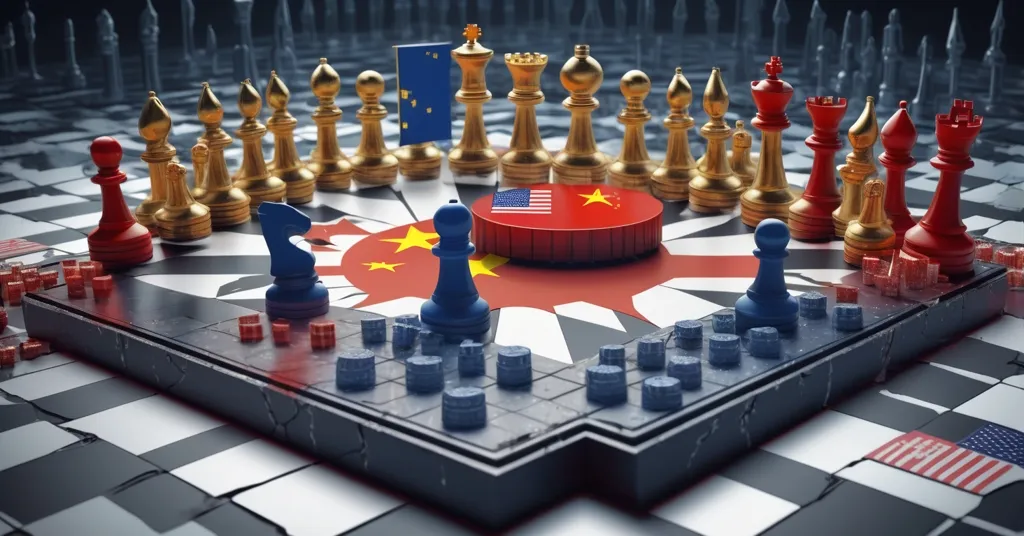ASML, Applied Materials Stocks Crash: U.S.-China Chip War Threatens Bitcoin Mining

ASML and Applied Materials Stocks Plummet as U.S. Slams China Chip Sales: A Threat to Bitcoin and Blockchain?
Turmoil has struck the semiconductor industry as a damning U.S. House committee report, released on October 7, accuses giants like ASML and Applied Materials of bolstering China’s chip-making prowess—and potentially its military power—through equipment sales. The fallout? A brutal stock market hit, with ASML shares nosediving 7.1% intraday in Amsterdam, and growing fears of harsher export controls that could ripple into the very hardware that powers Bitcoin mining and blockchain networks.
- Stock Carnage: ASML shares cratered 7.1% intraday, with Applied Materials and others like Tokyo Electron also taking heavy losses.
- U.S. Condemnation: A bipartisan report claims these firms are aiding China’s semiconductor and military ambitions, pushing for sweeping export bans.
- Crypto at Risk: Semiconductors are the lifeblood of Bitcoin miners and blockchain nodes—disruptions here could shake decentralized tech.
The Stock Shock: ASML and Applied Materials Under Fire
For those new to this arena, semiconductors are the tiny chips that drive everything from smartphones to fighter jets—and yes, the specialized rigs that mine Bitcoin. Controlling their production isn’t just a business matter; it’s a geopolitical chess match. ASML, a Dutch powerhouse, is the world’s sole maker of the most advanced lithography machines (specialized tools that etch circuits onto chips, a crucial step in manufacturing), while Applied Materials, a U.S. titan, supplies critical equipment for the process. When the U.S. House committee dropped its bombshell report, markets reacted instantly. ASML saw its sharpest intraday drop since July, though it’s still up 14% over the past year. Applied Materials, alongside peers like Tokyo Electron, KLA Corp, and Lam Research, also bled value as investors braced for what might come under the Trump administration. For more details on the report and its impact, check out this detailed coverage of ASML and Applied Materials’ stock dip.
China isn’t a side hustle for these companies—it’s a cash cow. ASML counts China as its second-largest market after Taiwan, with 27% of its net system sales in Q2 coming from there, mostly via less advanced deep ultraviolet (DUV) machines (a step below cutting-edge tech, still vital for mid-tier chips). Applied Materials is even more entangled, with over a third of its revenue rooted in China. Analysts warn of a staggering $710 million revenue loss next year if export rules tighten—a gut punch that’s roughly 10% of its annual China earnings. This dependency makes any whiff of new restrictions a direct threat to their bottom line.
Geopolitical Chess: U.S. vs. China Tech Dominance
The U.S. House committee pulled no punches in its October 7 findings, alleging that equipment sales by ASML, Applied Materials, and others are supercharging China’s semiconductor industry and, by extension, its military capabilities. While no laws were explicitly violated, the bipartisan panel urged the Trump administration to “dramatically expand country-wide bans and licensing requirements” on tool exports to China. This isn’t mere political posturing with teeth—it’s a visceral fear in Washington that Beijing’s chip advancements could upend global power dynamics. Semiconductors fuel artificial intelligence, defense systems, and economic might. Allowing China to close the tech gap is a non-starter for U.S. policymakers.
Export controls have been a thorn in this industry’s side for years. ASML can’t sell its top-tier lithography machines to China due to U.S.-led restrictions, and last year, the Dutch government, nudged by the Biden administration, blocked sales of its second-most advanced systems. The U.S. recently upped the ante, revoking Biden-era permissions that let companies like Samsung, SK Hynix, and TSMC supply Chinese factories without endless red tape. Meanwhile, the Trump administration is doubling down on domestic strength, taking a stake in Intel Corp to counter Asian dominance. The message is loud: America wants the semiconductor crown back.
China’s Tech Ambitions: A Middle Finger to Restrictions
Beijing isn’t twiddling its thumbs while the West tightens the screws. China is hell-bent on tech self-reliance, with Huawei quietly assembling a shadow network of semiconductor facilities to dodge export bans. Reports suggest dozens of covert plants are in play, focusing on everything from mobile chips to server-grade hardware. In September, Huawei rolled out a three-year chip development roadmap, aiming to rival U.S. tech head-on. Meanwhile, Hangzhou-based startup DeepSeek made waves in January with an AI model that competes with offerings from OpenAI and Meta—but at a fraction of the cost, reportedly undercutting U.S. equivalents by millions in development expenses. This isn’t just progress; it’s a bold statement that China can innovate around any blockade, whether it’s matching Nvidia’s AI processors or not.
Here’s the kicker: even the toughest export controls might just be speed bumps. China’s determination to build its own tech stack means that while bans can delay progress, they’re unlikely to stop it. For every door the U.S. slams shut, Beijing seems to find a back window. But at what cost to global collaboration and innovation? That’s the million-dollar question—or perhaps the million-Bitcoin one.
Crypto’s Collateral Damage: Mining and Blockchain Risks
For our crypto community, this isn’t some distant corporate spat—it hits close to home. Semiconductors are the beating heart of decentralized tech. Every Bitcoin miner relies on Application-Specific Integrated Circuits (ASICs), custom chips often produced by manufacturers tied to firms like TSMC, which are caught in this geopolitical crossfire. Ethereum nodes, Solana validators, and countless other blockchain systems depend on high-performance hardware too. If China corners chip production, or if U.S. bans disrupt supply chains, the balance of hashing power— the computational muscle securing Bitcoin’s network by solving complex puzzles—could shift dramatically. Imagine a world where Beijing prioritizes hardware for miners or protocols it favors. That’s a centralization risk Bitcoiners have fought tooth and nail to avoid.
Let’s play devil’s advocate for a moment. Could U.S. overreach backfire? Heavy-handed export controls might accelerate China’s self-reliance, leaving Western firms like Applied Materials bleeding revenue while Beijing builds its own empire. Worse, it could fracture global supply chains, making cutting-edge chips scarcer for independent miners and developers. On the flip side, this chaos might spark a silver lining for decentralization. If mainstream hardware becomes a choke point, could we see underground innovation—alternative mining tech or repurposed older chips—flourish outside superpower control? It’s a long shot, but crypto has always thrived on beating the odds.
For the OGs in our audience, consider this: miners might need to pivot fast. Sourcing older, less restricted chips or exploring unconventional hardware could become the next frontier. We’ve seen Bitcoin adapt to bans before—think China’s mining crackdown in 2021, which scattered hash rate globally. History shows our ecosystem doesn’t fold easily, but with hardware as the ultimate bottleneck, adaptability will be key. What happens to Bitcoin’s ethos of freedom if the chips powering it are pawns in a superpower showdown?
What’s Next: Export Bans or Tech Stalemate?
The road ahead is murky. The U.S. House committee lacks direct power to enforce bans—that’s the Commerce Department’s turf—but its recommendations carry clout in a political climate where both parties are eager to flex muscle against China. Will the Trump administration drop the hammer with sweeping export rules? It’s likely, given the rhetoric. But effectiveness is another story. China’s workaround game is strong, and every ban risks alienating allies or tanking Western profits more than Beijing’s ambitions. For now, markets are on edge, and companies like ASML and Applied Materials are stuck between a rock (massive China revenue) and a hard place (U.S. policy wrath).
Zooming out, this semiconductor clash exposes a brutal reality for the decentralized tech we champion. Hardware remains a chokepoint, no matter how borderless our blockchains aim to be. As Bitcoiners and blockchain advocates, we push for disruption and freedom, yet this battle reminds us that physical infrastructure can still be weaponized. U.S. controls might aim to protect national interests, but they could stifle the global collaboration crypto thrives on. Meanwhile, China’s rise in chip production could either threaten Bitcoin’s decentralization or force us to innovate beyond traditional supply chains. Either way, the stakes couldn’t be higher.
Key Questions and Takeaways on Semiconductor Crisis and Crypto Impact
- Why did ASML and Applied Materials stocks crash recently?
A U.S. House committee report on October 7 accused these semiconductor giants of supporting China’s chip industry and military through equipment sales, sparking fears of stricter export controls and triggering a market sell-off with ASML down 7.1% intraday. - How critical is China to semiconductor firms and Bitcoin mining hardware?
China accounts for 27% of ASML’s sales and over a third of Applied Materials’ revenue, a vital market for chip equipment that produces ASICs—specialized chips essential for Bitcoin mining operations. - What’s at stake for blockchain technology in the U.S.-China tech war?
Semiconductors underpin blockchain networks; control over chip production could skew Bitcoin’s hashing power or Ethereum’s node performance, risking centralization if one nation dominates supply. - Can U.S. export controls halt China’s semiconductor and AI progress?
Only to an extent—while bans slow China’s timeline, breakthroughs from Huawei’s shadow facilities and DeepSeek’s low-cost AI models prove they’re finding ways around restrictions, impacting global tech and crypto hardware access. - How might aggressive U.S. policies affect decentralized tech?
Overly strict export controls could splinter supply chains, restrict access to cutting-edge chips for miners and developers, and undermine the borderless innovation at the core of blockchain systems. - Could China’s chip advancements threaten Bitcoin’s decentralization?
Potentially, yes—if China leads in semiconductor production, it could influence hardware availability for certain networks or miners, creating imbalances in Bitcoin’s security, though it might also drive alternative, decentralized hardware solutions.
As advocates for breaking free from centralized control, we’re left with a bitter pill to swallow: the chip war between the U.S. and China isn’t just about semiconductors—it’s about who shapes the future of technology, including the decentralized systems we hold dear. ASML and Applied Materials are merely the latest casualties in a high-stakes game, but the tremors could shake Bitcoin’s foundation or force blockchain to evolve in ways we can’t yet predict. One certainty remains—until hardware itself is decentralized, true freedom in crypto will always have an Achilles’ heel. How do we hack that problem? That’s the puzzle worth solving.



